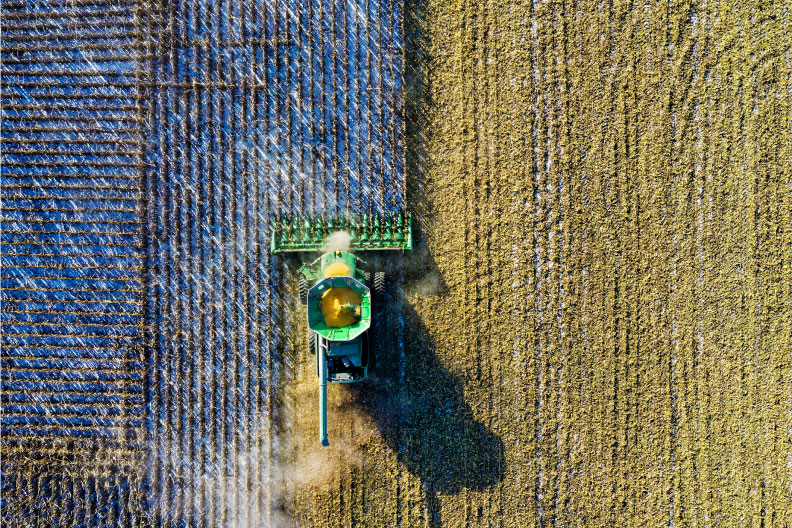By Jeff Keunen
Ruminant Nutritionist,
Grand Valley Fortifiers, Nutrition Direct
Good spring planting conditions and plenty of early season heat have helped corn plants grow well across many parts of the province. Most fields of corn were tasseled in mid-late July and thus harvest for corn silage will be underway earlier this year than traditional years. If you mark your calendars on the day your fields tassel, counting forward 40-45 days will give you a good estimate of when silage corn should be close to ½ milk line and very close to harvest ready. Following these well-known and research proven harvest management tips will help you ensure a high quality corn silage that will improve milk yield and reduce purchased feed costs for years to come.
Get Ready to Go
The harvest window for maximum corn silage quality and yield is quite small and may be earlier than normal for many this year, so be sure that you are ready when the corn is ready for optimum harvest. If you do your own chopping, make sure that your equipment is all serviced and ready to go. If you rely on a custom operator, be sure to keep them informed as your corn matures and the estimated date that you will need to have it chopped. In all cases make sure that your silo(s) are ready to go and needed maintenance is completed.
When to Chop
Corn should be harvested between ½ – ¾ kernel milk-line, but there is large variation in the relationship between kernel milk-line and whole plant moisture. Therefore, it is very helpful to chop approximately 10 whole plants (representative sample from the field) and determine the moisture as harvest time approaches. Once you know the current whole plant moisture content, expect the corn to dry down an average of 0.5% per day in typical weather, but up to 1% per day in hot and dry weather.
For optimum yield, starch (energy) content and silage fermentation, the goal for corn silage harvest is 35 – 40% dry matter for tower silos and 33 – 38% dry matter for bunk silos and bags. Chopping silage too wet will result in lower yield and lower starch content so that both milk per acre and milk per tonne of silage are reduced. Very wet corn silage may also have fermentation and feed out challenges. On the other hand, harvesting silage too dry will contribute to difficulty in packing, chopping and silage fermentation. It will also reduce digestibility of starch resulting in more corn in the manure and potentially feeding more grain in the ration to boost energy levels.
Chop Length and Processing
Chop length should be ½ inch to ¾ inch (12-18 mm) depending on processing and moisture level. Chopping short will reduce sorting at the feed bunk, increases packing density at ensiling, and helps improve intakes. Corn silage should be processed, however, lab samples and visual observations on farms show that most silage is not processed well enough. It is critical that almost all the kernels are crushed, just as it is for HM corn. This is especially true when silage is chopped above 33 – 35% dry matter. A very simple and effective test at harvest to see if corn silage is processed properly is to scoop silage into a 32 oz cup and then spread it out; if you see more than 1 or 2 half or whole kernels then processing can be improved. Discuss with the operator ways to tighten the roller or slow the harvest speed to improve processing. Excellent processing on corn silage ensures that the starch in the silage is well digested and improves milk yield per tonne of silage.
Use a Silage Inoculant
Many silage inoculants are available to speed-up fermentation at harvest and/or improve stability and quality of silage at feeding. Dairy producers should strongly consider using one to improve silage quality and reduce losses of dry matter and other nutrients. Since corn silage tends to spoil and heat at time of feeding, Buchneri products that are research proven to reduce this are recommended. It is best to use a product that contains more than one bacteria strain, one for lactic acid production at the start of fermentation and a Buchneri strain to increase bunk life.
Filling, Packing and Covering
All types of silos should be filled rapidly to exclude oxygen and begin fermentation. Silage in bunker silos must be packed and covered properly to drive out air and reduce dry matter loss and spoilage. Packing density should be at least 15 lbs of dry matter per cubic foot. The size and number of packing tractors must increase in proportion to the size of the silos and the speed of filling. Recommendations are that you need 800 lbs of packing tractor for every T/hr of silage coming to the bunk silo. That would be 80,000 lbs of tractor for 100 T/hr of silage. Cover bunker silos as soon as possible after filling and ensure that the plastic, whatever type is used, remains tight against the silage.
In Summary
Don’t get caught off guard this year with the potential for a much earlier corn harvest than traditional years. Have a discussion with your feed advisor about forage stocks, corn silage inventory needs, storage facilities, corn silage quality over the past few years, and good corn silage harvesting practices. Remember that making excellent quality corn silage for a couple harvest days this fall will pay you back for the rest of the year. Improving your harvest management and ensuring excellent quality corn silage is available for your herd to consume will lower your purchased feed costs, improve your milk yield and improve your farm’s profitability.
This article was written for the Fall 2021 Dairy Grist. To read the whole Dairy Grist, click the button below.

